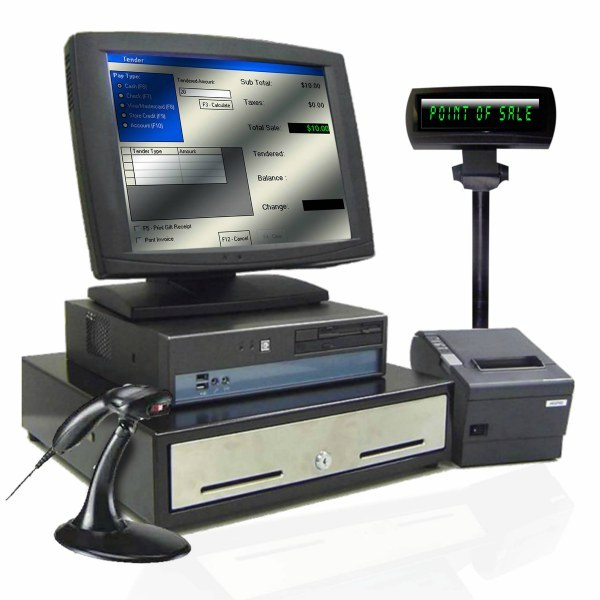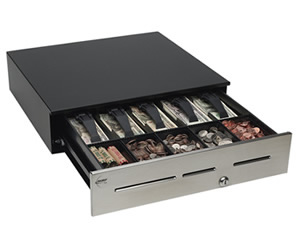Putting Together a POS System – Scanners, Printers and More

Regardless of the size of your business, at some point either early on, or maybe a few months after opening you will need a Point of Sale (POS) system to keep things running smoothly.
When starting your research, make sure to consider your retail software and POS hardware needs together. If not, the software you choose to run your business may not be compatible with the POS hardware you have or want. Not all scanners, weight scales, card readers, etc. will work with every software package.
The POS Hardware Components listed below are the standard components of a retail POS system.
All-In-One Workstations:
Workstations are designed to meet all of your "Cash Register" needs. Like standard computer technology they provide the expandability, flexibility, and eliminate configuration issues with an easy-to-setup package that comes complete with pre-configured peripherals devices. This POS setup often has a small countertop footprint, and is often used to smaller retail shops.
Backroom Servers and Power Sources:
Servers provide a powerful and flexible platform on which owners can run the retail, accounting, and other business software. Many server options today are flexible enough to double as POS Workstations.
Try to choose a hard drive (HD) with on-board RAID support for the most secure day-to-day backups and disaster recovery. And always remember to backup your files, as many businesses sometimes do not put adequate planning into this. Also try making each POS terminal have dedicated power and a battery-backup if possible. As an alternative to having your own server, you may choose to get software that runs over the Internet (in the "cloud"). One advantage to using an Internet based POS system (see MerchantOS or CashierLive) is that they include updates, support AND data backup in one monthly fee.
 Barcode Scanners:
Barcode Scanners:
Scanners allow high-speed, accurate input of inventory and bar code information. Scanners will also help reduce errors during checkout, and a hands-free bar code scanning option will maximize efficiency. Depending on the type of business you are in you can elect for a short-range scanners (to scan items right in front the cashier), long-range scanners (to accurately scan from further away), and embedded scanners (installed in the tabletop of checkout counters.)
 Cash Drawer:
Cash Drawer:
In addition to holding cash, a cash drawer needs to securely protect various checks, credit card receipts, and any other currency or documents that change hands with your daily transactions. If theft is a concern, choose retail software with a "Compulsory Close" feature to help prevent clerks from leaving a cash drawer open longer than necessary. Cash drawers can be connected directly to your retail POS system's serial, parallel, USB, or through a POS printer with cash-drawer ports.
Check Readers (MICRs):
Magnetic Ink Character Recognition (MICR) devices scan the magnetically encoded routing numbers, bank accounts, and check numbers that appear along the bottom of standard personal or business checks. MICR Readers can be standalone devices or combined with a receipt printer or a "Keyboard Wedge" device, which means they are connected through your keyboard. If your customers rely on personal checks (and believe it or not, it's still common these days), you can verify the account information to prevent non-payment. If you have enough volume to justify it, make sure your POS software can support it.
Magnetic Stripe Readers (MSRs) and PIN Pads:
MSRs obviously read credit cards, debit cards, gift cards, customer loyalty cards, and employee ID cards. MSRs can be stand-alone or integrated with the POS terminal or keyboard. Be sure to use retail software with Internet Gateway Processing for the fastest credit card authorizations. A PIN (Personal Identification Number) Pad is required for debit card processing.
Signature Capture Devices:
Electronically capture the customer's signature for processing credit cards, A/R charge payments, and other transactions that require signature verification.
 Receipt Printers:
Receipt Printers:
Print customer receipts with a compact receipt printer, or choose a standard printer for full-size invoices, purchase orders, reports, and other documents. To save valuable time during checkout, choose a receipt printer that offers easy, drop-in paper loading.
Some other items to consider:
Touch Screens or Keyboard:
You will have two main choices to operate your POS, a touch screen or through keyboard. In this day and age, touch screens are the more popular option. First of all, it's a space saver. Everything runs and operates in a single device without the need for extra components and wiring. It is extremely user-friendly. Most touch-screens are programmed so you can navigate through menus using your finger or a stylus. If counter space is a concern, choose a compact keyboard design, and keyboards with built-in touchpad to eliminate the need for a mouse.
Label Printers:
Print labels for items, customers, and vendors, along with shipping labels, file folder labels, or many other types of labels. Thermal label printers use heat-sensitive label stock to produce durable, fade-resistant labels.
A Time Clock will eliminate costly mistakes caused by manual time tracking. Secure clock-in/clock-out features also prevent illegal manipulation of employee hours.
Many POS software products have an Employee Time clock built in.
Portable Data Terminals:
Handheld PDTs are portable bar code scanners used to gather information which can be imported into your retail software. They will increase speed and efficiency during physical counts and inventory. great also to quickly count merchandise during receiving and store-to-store transfers.
Tablet Devices:
Lightweight, handheld tablet PCs are used for mobile applications. This is an ideal choice for outdoor or large-lot businesses, such as Building Materials or Construction. For a completely portable retail POS system, choose a tablet PC that offers mobile printing and payment options.
We hope this gives you a great jumping-off point for your shopping list. Be sure to talk to some technology vendors about the best POS Hardware/Software solutions for your specific business, and visit Barcode.com and Pointofsale.com for various reviews and articles concerning Hardware/Software solutions in action.
{jcomments on}
Was this article useful? Subscribe to our weekly(ish) email newsletter to receive more great articles about bar code technology.
Follow us on Twitter to get daily updates: Barcode.com on Twitter
Other articles that may interest you:
How to choose a POS VAR (Value Added Reseller)
Top Ten Reasons Point of Sale Systems are Better Than Cash Registers
Point of Sale Software – Top 10 Mistakes to Avoid When Choosing a POS System
